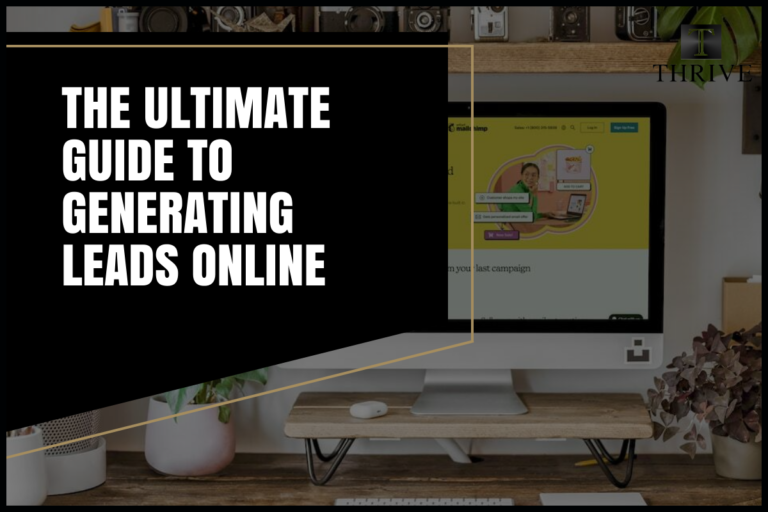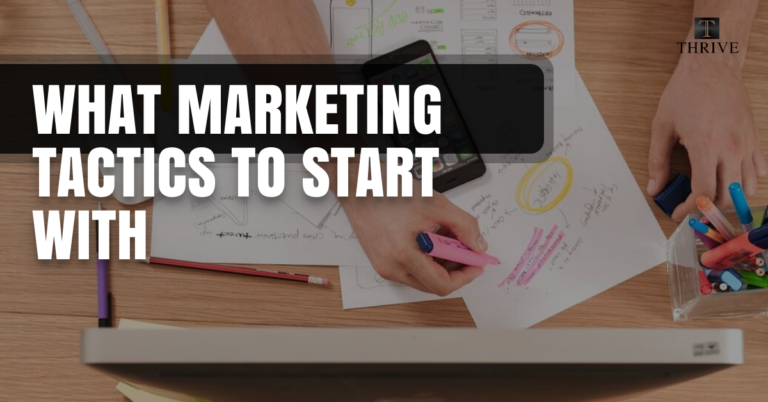
Every business needs lead generation to survive. . .
It is a cornerstone of every successful marketing strategy.
In today’s fiercely competitive marketplace, nothing beats a solid lead generation strategy in driving business success. By actively identifying and engaging potential customers, businesses can rise above the rest and become true industry leaders.
Establishing your brand as the go-to solution provider significantly increases your chances of attracting new customers and nurturing long-term loyalty.
Where most business owners get stuck: Starting with your target market
In my experience, this is where most business owners get stuck. Either they don’t niche down enough or they don’t go deep enough to make this work and it only ends in massive frustration when their marketing doesn’t work.
What I mean by this is when you listen to marketers online they use generic terms like struggles, pain points and solve problems. But if you are solving generic problems and you do not call your ideal client out – your marketing will not work.
You must dive deep into psychology that gets attention, that gets results and makes digital marketing work! If you need help with this I do this for you in my lead generation services. (I suggest you book a free strategy call to discuss your specific needs)
Understanding Your Target Market is key to generating leads in an innovative and empowering way. It is crucial to have a deep understanding of your target audience, individuals, or organizations who are most likely to be interested in your products or services. By comprehending their characteristics, preferences, and needs, you can tailor your lead generation strategy to resonate with them. I suggest the following key steps to understand your target audience:
- Market Research: Conducting thorough market research to gain insights into your industry, competitors, and target market is foundational. This research will help you understand the broader context in which your target audience operates, market trends, and emerging needs or gaps that your business can address. Many don’t realize that SBA offers to do this for you for FREE.
- Demographics and Psychographics: Define the demographic and psychographic profiles of your target audience. This includes characteristics such as age, gender, location, income level, lifestyle choices, and motivations. This information creates a clearer picture of your ideal customers. This data will be used mostly for running ads but may also be considered in making sure your services align.
- Buyer Personas: Developing buyer personas is critical in crafting messages that are tailored to resonate with specific segments of your target audience. A buyer persona encapsulates the characteristics, goals, challenges, and preferences of your ideal customers. Creating multiple personas allows you to address the diverse needs and pain points of different customer segments. PRO TIP: This should go deeper than general challenges. When you are finished you should be able to attach every social media post, every piece of content to a specific struggle or pain point.
Let's go deeper into pain points your ideal client is facing
Defining your ideal client persona extends beyond general demographics. It involves delving deep into your target audience’s mindset to identify their pain points – the problems, challenges, or frustrations they encounter. By doing so, you position your products or services as viable solutions.
Here are a few ways that you can define your ideal client persona and identify their pain points and again, if you want this done for you we offer this as part of our services:
- Data Analysis: Analyze your existing customer base, market research, surveys, and customer feedback for commonalities, recurring patterns, and themes regarding challenges, needs, and preferences. With this data-driven approach, valuable insights can be achieved. A great book that will teach you how to survey your community is called “The Ask Method”
- Empathy and Empirical Research: Connect with your ideal client by stepping into their shoes to understand their experiences and emotions. Conduct interviews or focus groups with existing customers to gain firsthand insights into their pain points.
- Pain Point Prioritization: Once identified, prioritize the pain points based on significance and impact on your target audience. Determine which aligns with your business offerings and is feasible for you to address effectively. Focusing on the most critical pain points creates tailored lead-generation efforts that resonate with your target audience. This is super important because if your offerings, content, and posts do not align with the right pain points you will not generate leads.
- Solution Mapping: Map your products or services to the pain points and articulate how they can alleviate those pain points. Demonstrating how you can provide tangible solutions positions your business as a valuable resource that increases the likelihood of generating qualified leads. This is where story telling and sharing how you understand your ideal client comes in.

Marketing Tactics To Get More Leads
Below are a few marketing tactics that generate leads for your business.
PRO TIP: If you find yourself in a situation where you have utilized these tactics and still do not get results it is because you have not gone deep enough into your target market’s needs and harnessed the psychology piece of marketing to communicate your brand.
- Content Marketing: Develop high-quality, informative, and engaging content that caters to the interests and needs of your target audience. Whether it’s blog posts, articles, videos, or infographics, create content that educates, entertains, or solves problems for your audience. Focus on providing value and building trust rather than promoting your products or services outright.
- Search Engine Optimization (SEO): Optimize your content for search engines to increase its visibility and reach. Conduct keyword research to identify relevant keywords and incorporate them strategically into your content. By ranking higher in search engine results, you enhance your chances of attracting quality leads who are actively seeking information or solutions related to your offerings.
- Social Media Marketing: Get social with your target audience! Utilize platforms that align with your customer’s preferences. Develop a strong social media presence and share compelling content that sparks engagement and encourages interaction. Leverage social media advertising and targeting options to reach your ideal customers directly.
- Email Marketing: Keep the conversation going with your customers. Implement an email marketing strategy to nurture leads and maintain ongoing communication. Provide valuable content, exclusive offers, or personalized recommendations to your subscribers. Segment your email list based on buyer personas and tailor your messages to their specific interests and needs.
- Influencer Marketing: Remember to tap into the power of influencers! Collaborate with relevant industry experts who have a strong following and influence among your target audience. By partnering with influencers, you can tap into their established trust and credibility, expanding your reach and attracting quality leads who value their recommendations.
How To Convert Leads To Buyers
Converting leads into customers is the ultimate aim of any lead generation strategy. And to get there, not only do we have to capture leads, but we also need to guide and nurture them through the conversion funnel until they take the plunge.
- Exciting Follow-up: We know the value of the first impression. Follow up promptly, be it by addressing them by their name, talking about their particular needs, or simply showing them how you can help. Your personal touch will keep them engaged and motivated to convert into loyal customers.
- Nurturing Campaigns: Ensure that each stage of the customer journey is enriched with value – valuable information, educational emails, informative blog posts, or exclusive offers – always keeping in mind their needs and preferences. By nurturing leads with customized resources, you establish trust and expertise and increase the chances of conversion.
- Comprehensive Call-to-Actions (CTAs): Your clear and compelling CTAs guide leads towards the conversion process, be it downloading a whitepaper, scheduling a demo, or making a purchase – all this seamlessly and without any unnecessary hiccups. With well-designed CTAs, you prompt action and simplify the conversion process.
- Smarter Lead Scoring: We believe in prioritizing our efforts on leads that are more likely to convert. By assigning values to different lead attributes and behaviors, you can identify highly qualified leads, allocate your resources accordingly, and maximize conversion rates. With smarter lead scoring, you make sure our approach is always targeted, streamlined, and efficient.

Optimization of your sales process
Are you ready to achieve higher conversion rates and maximize your lead generation efforts? Nurturing leads and optimizing conversion funnels are critical for success, and I’ve got some innovative and empowering tips to help you get there!
Let’s start by segmenting your leads based on their characteristics, interests, and behaviors.
By understanding the unique needs of each segment, you can deliver targeted content that resonates with their preferences and pain points. This insight-driven approach is key to increasing the relevance and effectiveness of your communication.
To keep your leads engaged and nurture their interest, you’ll need to continuously provide informative and valuable content. This will position your business as a trusted resource, build credibility, and increase the chances of conversion. Consider blog posts, case studies, videos, or webinars to educate, inform, and address your leads’ pain points.
Marketing automation is the way forward to streamline and personalize your lead nurturing efforts.
With automated workflows and personalized messaging, you can scale your lead-nurturing campaigns while maintaining a conversational tone that enhances efficiency and effectiveness.
Optimizing your landing pages is essential for higher conversion rates.
You’ll need clear and compelling headlines, persuasive copy, and visually appealing designs. Minimize distractions and guide leads toward the desired action with a professional and persuasive tone. Test different elements such as layout, CTA placement, and form fields to optimize your landing pages effectively.
Lastly, regularly analyzing your conversion funnels and tracking key metrics will help you identify areas of improvement.
Use this insightful data to make data-driven optimizations, experiment with different strategies, and iterate on your lead nurturing and conversion tactics. Let’s achieve success together!
Why Measure KPIs?
Measurement and optimization form the backbone of any successful lead generation strategy. This is what helps you to tighten up your marketing efforts to focus in what is working and to improve your strategy. You cannot simply put a landing page up and expect leads to pour in – you have to measure and tweak until it works.
These essential components allow you to continuously refine and maximize the effectiveness of your efforts, all driven by data-driven insights. Let’s dive into why measurement and optimization are so important:
- Data-Driven Decision Making: By measuring key performance metrics such as conversion rates, lead quality, and cost per lead, you can make informed decisions based on solid evidence rather than assumptions. This data-driven approach ensures that your strategies are grounded in real-world results.
- Identifying Effective Channels and Tactics: Through tracking and analysis, you can identify the most effective channels and tactics for generating high-quality leads. Understanding which marketing channels, campaigns, or content formats yield the best conversion rates empowers you to allocate resources wisely, focusing on the areas that deliver the greatest results. This optimization improves efficiency and boosts your return on investment (ROI).
- Refining Targeting and Messaging: Measurement provides valuable insights into your target audience’s preferences, behaviors, and responses. Analyzing data on lead demographics, interactions, and conversions enables you to refine your targeting and messaging strategies. This personalization allows you to speak directly to your audience’s pain points and tailor your offerings to resonate deeply with them.
- Continuous Improvement: Measurement and optimization create a continuous improvement loop. By tracking the performance of your lead generation efforts, identifying areas of underperformance, and making data-driven optimizations, you can refine your strategies over time. This iterative approach ensures that you can adapt to market changes, stay ahead of competitors, and continually enhance the effectiveness of your lead generation.
- Cost Efficiency: Measurement and optimization can lead to cost savings and improved cost efficiency. By identifying underperforming channels or tactics, you can reallocate resources to areas that yield better results. Additionally, optimization helps eliminate wasteful spending and enables you to focus on strategies that generate high-quality leads at a lower cost per acquisition.
Tracking and analyzing lead generation efforts play a pivotal role in refining strategies and driving improved results. Let’s explore why tracking and analysis are so vital:
- Data-Backed Insights: By tracking and analyzing lead generation efforts, you gain valuable insights into the effectiveness of your strategies. Monitoring key metrics such as lead conversion rates, lead source attribution, and customer acquisition costs provides a deeper understanding of what’s working and what needs improvement. Armed with these insights, you can make informed decisions and fine-tune your lead-generation strategies accordingly.
- Refinement of Targeting and Segmentation: Tracking and analysis help you uncover patterns and trends among your leads. By segmenting your leads based on characteristics, behaviors, or demographics, you can tailor your marketing efforts to specific audience segments. This level of refinement allows you to deliver more targeted and personalized messages, resulting in higher engagement and conversion rates.
- Optimization of Marketing Channels: Tracking and analysis empower you to evaluate the performance of different marketing channels. By monitoring metrics such as click-through rates, conversion rates, and cost per lead across various channels, you can determine which channels drive the most qualified leads and deliver the best ROI. This optimization ensures that your resources are allocated to the most effective channels, maximizing your lead generation results.
- Identification of Bottlenecks and Improvement Opportunities: Through tracking and analyzing the conversion funnel, you can identify bottlenecks and areas where leads drop off. Whether it’s a poorly optimized landing page, a confusing call-to-action, or a lack of follow-up, identifying these obstacles enables you to make targeted improvements. Optimizing the conversion funnel increases the likelihood of converting leads into customers and drives overall business growth.
- Iterative Improvement and Innovation: Tracking and analyzing lead generation efforts support an iterative approach to optimization. Continuously monitoring and analyzing data allows you to experiment with new strategies, tactics, and messaging. This iterative improvement process fosters innovation, encourages creative thinking, and keeps your lead-generation efforts one step ahead of the competition.

Testimonials and Social Proof
In the world of lead generation, customer testimonials and social proof play a vital role in building trust, credibility and influencing potential leads.
Positive reviews, case studies, and testimonials from satisfied customers have the power to validate the value of your products or services, creating a strong impact. In fact, if you are selling a high-ticket offer you will want to double down on your testimonials, the more you have the more successful your sales will be.
One of the primary reasons customer testimonials are critical in lead generation is their ability to establish trust.
When potential leads see real customers sharing their positive feedback and experiences, it instills confidence in your brand and offerings. Testimonials act as social proof, demonstrating that others have had a positive experience and received desired outcomes through your products or services. This trust-building element is vital as it helps overcome skepticism and reduces the perceived risk associated with making a purchasing decision.
Customer testimonials contribute to the credibility of your business.
When potential leads encounter authentic and relatable experiences shared by real customers, it adds legitimacy to your brand. Testimonials provide evidence that your products or services deliver on their promises and can solve the pain points of your target audience. This credibility boosts your reputation and distinguishes your business from competitors, making it more appealing to potential leads.
Customer testimonials have a persuasive and compelling effect on the decision-making process of potential leads.
By showcasing the positive outcomes and benefits achieved by existing consumers, testimonials create a sense of desire and influence the perception of value. When potential leads can relate to the challenges and successes shared in the testimonials, they are more likely to envision themselves experiencing similar results. This emotional connection can tip the scales in favor of choosing your business over competitors.
To maximize the impact of customer testimonials and social proof, it’s essential to diversify the types of testimonials you showcase.
Apart from written testimonials, consider incorporating video testimonials, case studies, and success stories. These formats provide a more immersive and compelling experience for potential leads, allowing them to see and hear real-life accounts of the value your business offers. Additionally, it’s important to display testimonials in conversation with potential leads to facilitate their decision-making process.
Lead Scoring Qualification
The significance of lead scoring and qualification lies in their capacity to identify and prioritize leads with the highest potential for conversion.
In the dynamic landscape of lead generation, not all leads are equal. Some show greater engagement, interest, and proximity to making a purchasing decision. By assigning a numerical score or utilizing a sophisticated grading system that considers factors like behaviors, demographics, interactions, and other pertinent criteria, businesses can discern the quality of leads and tailor their follow-up actions accordingly.
A well-defined and forward-thinking lead scoring system empowers sales teams to focus their efforts on leads that have demonstrated a higher level of interest and engagement.
Instead of expending valuable time and resources on leads with limited conversion potential, sales representatives can streamline their activities and devote their energy to nurturing and closing deals with the most qualified prospects. This innovative approach enhances efficiency, minimizes wasted effort, and augments overall conversion rates.
Implementing a state-of-the-art lead scoring system also fosters an environment of collaboration and shared goals between marketing and sales teams.
By establishing crystal-clear criteria and definitions for lead qualification, both teams can synchronize their understanding of what constitutes a qualified lead. This alignment ensures that marketing endeavors concentrate on attracting and nurturing leads that align precisely with the sales team’s requirements, resulting in a seamless handoff process and a heightened likelihood of conversion.
A robust lead scoring system takes into account various influential factors to determine the quality of leads.
These factors encompass the depth of engagement with marketing content, website interactions, email responses, demographics, firmographics, and the specific actions taken by each lead. By assigning distinct point values to these criteria, businesses can effectively prioritize leads based on their overall score or grade. This comprehensive approach aids in identifying leads that are most likely to convert and facilitates tailored communication and follow-up strategies for maximum impact and results.
Aligning Lead Nurturing and Sales
One of the key drivers of successful lead generation lies in the innovative alignment between marketing and sales teams. When these two powerhouses work in harmony, the potential to effectively nurture leads and drive conversions becomes limitless. In this discussion, we will explore the profound importance of fostering a strong relationship between these departments, facilitating seamless handoffs, and optimizing the lead nurturing process. The better your marketing the easier your sales will be.
The alignment of marketing and sales teams is a catalyst for success, as it ensures a shared objective: converting leads into satisfied customers.
By embracing open lines of communication and collaborative efforts, marketing and sales can join forces to gain a profound understanding of the target audience’s needs and pain points. This invaluable insight allows them to develop highly targeted campaigns and craft a customer journey that seamlessly guides prospects toward conversion.
To establish an environment of synergy and trust between marketing and sales, it is imperative to foster regular meetings and encourage cross-functional collaboration.
By consistently sharing insights, data, and feedback, both teams gain invaluable knowledge about the buyer’s journey. This enables them to align their messaging, fine-tune their strategies, and continuously enhance the lead nurturing process. Furthermore, the integration of insights from sales teams empowers marketers to make data-driven adjustments and optimize their lead-generation efforts.
Seamless handoffs between marketing and sales teams are paramount in ensuring that leads receive the utmost care throughout their journey.
Establishing clear processes and protocols for passing leads from marketing to sales is pivotal. An effective lead scoring system can be employed to assess the quality and readiness of leads before they are transitioned to the sales team. Moreover, the implementation of Service Level Agreements (SLAs) fosters a shared understanding of expectations, response times, and responsibilities for lead follow-up. These measures ensure that leads receive prompt attention and the nurturing they deserve.
Optimizing the lead nurturing process requires an enthusiastic blend of effective communication, personalized messaging, and a commitment to continuous improvement.
Marketing teams can equip sales teams with detailed information about leads, including their interests, behaviors, and engagement history. Armed with this invaluable knowledge, sales teams can personalize their interactions, demonstrating an understanding of the prospect’s pain points and offering tailored solutions. Feedback from sales teams serves as a catalyst for marketing teams to refine their lead generation strategies and improve the quality of leads generated.
Harnessing the power of innovative marketing automation and CRM systems can significantly elevate the lead nurturing process.
Automation empowers businesses to deliver timely and relevant content to leads at various stages of the sales funnel, ensuring that they receive the right information at the right moment. Seamless integration between marketing automation and CRM systems unlocks a holistic view of lead interactions and progress, enabling both teams to make informed decisions and navigate the journey to conversion with precision.
Conclusion
Lead generation is not just a buzzword; it’s a powerful driver of business growth.
By embracing innovative strategies and approaches, you can transform your lead generation efforts into a dynamic engine that fuels your success. Understanding your target audience is key. When you have a deep understanding of their needs, pain points, and aspirations, you can craft personalized messaging that resonates with them on a profound level.
A clear value proposition is essential in capturing the attention and interest of your potential leads. You must communicate the unique value your product or service brings to the table and demonstrate why it’s the perfect solution for their challenges. Empower your audience with knowledge and insights through compelling content, whether it’s informative blog posts, engaging videos, or thought-provoking webinars; delivering high-quality content positions you as a trusted industry authority and nurtures long-lasting relationships with your leads.
Choosing the right marketing channels is another critical aspect of successful lead generation. Innovative and enthusiastic approaches can help you explore new avenues and leverage emerging platforms. Experiment with different channels to identify the ones that resonate most with your target audience. Whether it’s social media, email marketing, search engine optimization, or influencer partnerships, find the channels that allow you to connect with your leads in meaningful and impactful ways.
However, the work continues after attracting leads.
Continuous measurement and optimization are essential to refine your strategies and achieve better results. Keep a pulse on your lead generation efforts by tracking and analyzing key performance metrics. Dive deep into the data to uncover insights that can inform your decision-making and drive continuous improvement. With each iteration, you’ll gain invaluable insights that empower you to fine-tune your strategies and elevate your lead generation game to new heights.
If you would like support in your journey, we offer done for you services! We will guide you through this process and do the work for you. We offer 3 different levels of services depending on where you are at in your lead generation journey. Book a call today for FREE marketing strategy session.



